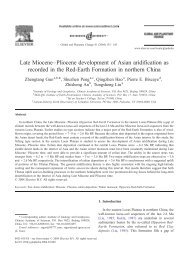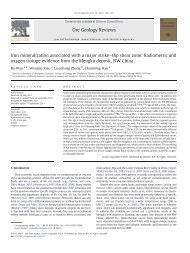constraints from fluid inclusions and Sr, C a
constraints from fluid inclusions and Sr, C a
constraints from fluid inclusions and Sr, C a
You also want an ePaper? Increase the reach of your titles
YUMPU automatically turns print PDFs into web optimized ePapers that Google loves.
6 K. LI et al.<br />
Table 2 Mn <strong>and</strong> Fe contents of different calcites.<br />
Well Formation Depth (m) Occurrence Mn (lg g )1 ) Fe (lg g )1 )<br />
S65 O 1-2 y 5733.21 Frac. Cc-2 89 300<br />
S76 O 1-2 y 5744.8 Frac. Cc-3 106 200<br />
S85 O 1-2 y 5964.6 Frac. Cc-1 232 498<br />
S78 O 1-2 y 5329.2 Karst Cc-1 232 797<br />
S65 O 1-2 y 5532.79 Karst Cc-2 83 700<br />
S65 O 1-2 y 5732.24 Karst Cc-2 91 400<br />
crosscut by type III (Fig. 4C,D). Type I fracture-filling calcite<br />
occurs as fine crystals <strong>and</strong> type II <strong>and</strong> type III fracturefilling<br />
as fine to coarse euhedral crystals. Under cathodoluminescence<br />
(CL), type I calcite is dull red, type II calcite is<br />
nonluminescent <strong>and</strong> has a Mn content of 89 lg g )1 <strong>and</strong><br />
Fe of 300 lg g )1 in well S65 (Tables 2 <strong>and</strong> 3), <strong>and</strong> type<br />
III calcite is dull red with Mn of 106 lg g )1 <strong>and</strong> Fe<br />
200 lg g )1 in well S76 (Fig. 4C–F).<br />
Karst-filling calcite is calcite that has grown in a palaeocave<br />
with a diameter more than 6 to 15 mm (Ford & Ewers<br />
1978); it shows giant forms with crystal sizes <strong>from</strong><br />
about 1–5 mm (Fig. 4B) <strong>and</strong> were found in the Lower to<br />
Middle Ordovician <strong>from</strong> wells S65, S72, S75, <strong>and</strong> S85<br />
with a thickness up to 6 m. The calcites have two different<br />
CL responses: nonluminescent CL in wells S65 <strong>and</strong> S75<br />
with Mn <strong>from</strong> 83 to 91 lg g )1 (n = 2, Table 2) <strong>and</strong> Fe<br />
<strong>from</strong> 400 to 700 lg g )1 , <strong>and</strong> dull red – orange yellow CL<br />
in wells S72, S78, <strong>and</strong> S85 with Mn 232 lg g )1 <strong>and</strong> Fe<br />
<strong>from</strong> 498 to 797 lg g )1 (Fig. 4C,D,G–J).<br />
Barite occurs as tabular, vug-fillings, <strong>and</strong> crosscuts karstfilling<br />
giant calcite crystals (Fig. 4K).<br />
Interparticle calcite cements are present in three stages.<br />
Stage I-1 calcite is cloudy, fibrous or radiaxial fibrous <strong>and</strong><br />
nonluminescent (Fig. 4M,N); this type of calcite has been<br />
reported <strong>from</strong> normal marine diagenetic environments<br />
(Moore 2001). Stage I-2 calcite is bladed <strong>and</strong> granular <strong>and</strong><br />
red to orange yellow CL colors (Fig. 4O,P). Stage I-1 calcite<br />
was infrequently followed by stage I-2 calcites. Stage<br />
II occurs as blocky crystals (>0.1 mm) in the center of<br />
pores <strong>and</strong> dull red CL (Fig. 4O,P). Stage III calcite occurs<br />
as coarse crystals <strong>and</strong> is nonluminescent under CL.<br />
Homogenization temperature (HT) <strong>and</strong> salinity<br />
Seventeen samples were doubly polished <strong>and</strong> analyzed for<br />
<strong>fluid</strong> <strong>inclusions</strong>. Abundant <strong>fluid</strong> <strong>inclusions</strong> were observed<br />
in fracture-, karst-fillings <strong>and</strong> calcite cements (collectively<br />
called diagenetic calcite). Most of the <strong>inclusions</strong> occur in<br />
planar arrays along growth b<strong>and</strong>ing <strong>and</strong> appear to be primary<br />
<strong>and</strong> therefore were probably trapped during primary<br />
crystal growth of the minerals. Some of the <strong>inclusions</strong> are<br />
distributed across CL-defined growth b<strong>and</strong>ing <strong>and</strong> thus are<br />
secondary. Although some monophase, liquid aqueous<br />
<strong>inclusions</strong> were observed in type I fracture-filling calcite<br />
<strong>and</strong> late calcite <strong>fluid</strong>-inclusion assemblages (FIAs), most of<br />
the <strong>fluid</strong> <strong>inclusions</strong> are 2-phase aqueous vapor–liquid. In<br />
the following section, only aqueous 2-phase primary <strong>inclusions</strong><br />
were measured for homogenization temperatures <strong>and</strong><br />
salinities.<br />
The type I fracture-filling calcite contains a few <strong>fluid</strong><br />
<strong>inclusions</strong>. The <strong>fluid</strong> <strong>inclusions</strong> occur mainly as singlephase<br />
aqueous <strong>inclusions</strong> <strong>and</strong> have sizes




